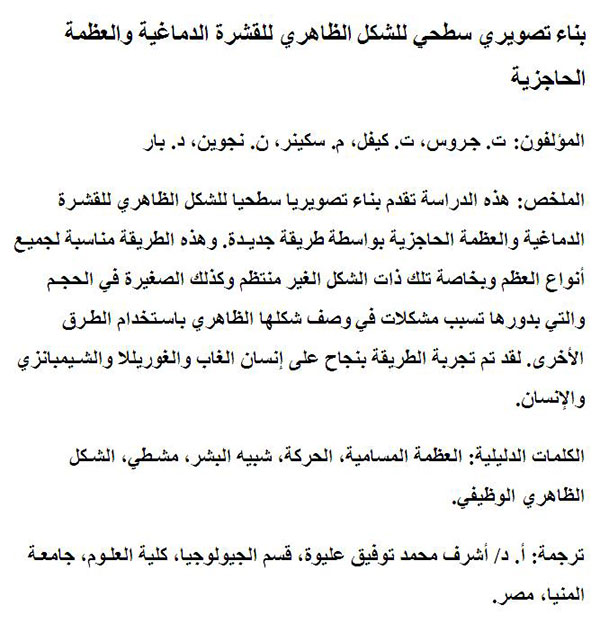A CT-image-based framework for the holistic analysis of cortical and trabecular bone morphology
Plain Language Abstract
This study introduces a standardized framework for the holistic analysis of cortical and trabecular bone structure. This method, although applicable to all bones of the skeleton, is particularly useful for irregular-shaped or small bones for which the application of traditional methods has been especially challenging. Traditional analyses have quantified cortical or trabecular structure in only selected regions of a bone, such as single cross-sections of cortical bone or volumes of interest of trabecular structure in epiphyses. The proposed method improves on these traditional methods by visualizing and quantifying the internal bony structure throughout the entire bone and in user-defined anatomical subregions. Here, we describe and demonstrate the method using high-resolution microtomographic scans of a first metacarpal of an orangutan, gorilla, chimpanzee and human. Using automated morphological filters, the cortical bone is defined and extracted from the underlying trabecular structure to create two 3D models, one of the cortex and one of the trabecular bone, that can be analysed separately. We test the sensitivity of the morphological parameters used to create these 3D models, demonstrating that the parameters defined here are robust and can provide accurate measures of cortical thickness, relative bone density, trabecular orientation, trabecular thickness and degree of anisotropy. This new, holistic method is able to reveal morphological and functional information about bone loading that is obscured or ignored using traditional methods, thus providing more informed interpretations of behaviour in extant and fossil taxa.
Resumen en Español
text
Traducción: Enrique Peñalver
Résumé en Français
Un système fondé sur les images CT pour l'analyse globale de la morphologie de l'os cortical et trabéculaire
Cette étude présente un système normalisé pour l'analyse globale de la structure de l'os cortical et trabéculaire. Cette méthode, bien qu'applicable à tous les os du squelette, est particulièrement utile pour les os de forme irrégulière ou petits pour lesquels l'application des méthodes traditionnelles a été particulièrement difficile. Les analyses traditionnelles ont quantifié la structure corticale ou trabéculaire dans des régions sélectionnées d'un os, comme des sections simples d'os cortical ou des volumes d'intérêt de la structure trabéculaire dans épiphyses. La méthode proposée améliore ces méthodes traditionnelles par la visualisation et la quantification de la structure osseuse interne dans l'ensemble de l'os et dans les sous-régions anatomiques définis par l'utilisateur. Ici, nous décrivons et démontrons la méthode en utilisant des scans microtomographiques à haute résolution du premier métacarpien d'un orang-outan, d'un gorille, d'un chimpanzé et d'un homme. En utilisant des filtres morphologiques automatisés, l'os cortical est défini et on l'extrait à partir de la structure trabéculaire sous-jacent afin de créer deux modèles en 3D, le cortex de l'un et l'autre de l'os trabéculaire qui peuvent être analysés séparément. Nous testons la sensibilité des paramètres morphologiques utilisés pour créer ces modèles 3D, ce qui démontre que les paramètres définis ici sont robustes et peuvent fournir des mesures précises de l'épaisseur corticale, la densité relative de l'os, l'orientation trabéculaire, l'épaisseur trabéculaire et le degré d'anisotropie. Cette nouvelle méthode holistique est en mesure de révéler des informations morphologiques et fonctionnelles sur le chargement de l'os qui est obscurci ou ignoré selon les méthodes traditionnelles, offrant ainsi des interprétations plus informées de comportement dans des taxons actuels et fossiles.
Mots-clés: os spongieux; locomotion; hominoïdes; métacarpien; morphologie fonctionnelle
Translator: Kenny J. Travouillon
Deutsche Zusammenfassung
Ein CT-basierter Rahmen für die holistische Analyse von kortikaler und traberkulärer Knochenmorphologie
Diese Studie stellt einen standardisierten Rahmen für die holistische Analyse von kortikaler und traberkulärer Knochenstruktur vor. Die Methode ist, obwohl sie für alle Knochen im Skelett angewendet werden kann, besonders gut bei iregulär geformten oder kleinen Knochen bei denen traditionelle Methoden besonders schwierig anzuwenden sind. Traditionelle Analysen haben kortikale oder traberkuläre Strukturen nur in ausgewählten Knochenegionen wie einzelnen Querschniten von kortikalen Knochen oder bei bedeutenden traberkulären Strukturen in den Epiphysen quantifiziert. Die vorgeschlagene Methode verbessert diese traditionellen Methoden indem sie die interne Knochenstruktur überall im Knochen in benutzerdefinierten anatomischen Subregionen visualisiert und quantifiziert. Hier beschreiben und zeigen wir diese Methode mit hochauflösenden mikrotomografischen Aufnahmen des ersten Metacarpale eines Orang-Utans, Gorillas, Schimpansen und Menschen. Mit automatischen morphologischen Filtern wird der kortikale Knochen definiert und aus der unterliegenden traberkulären Struktur extrahiert um zwei 3D Modelle zu erstellen, eines vom Cortex und eines vom traberkulären Knochen, das separat analysiert werden kann. Wir testen die Sensibilität der morphologischen Parameter mit denen diese 3D Modelle erzeugt wurden und demonstrieren, dass die hier definierten Parameter robust sind und accurate Maße der kortikalen Dicke, der relativen Knochendichte, der traberkulären Orientierung und Dicke und des Anisotropiemaßes liefern können. Diese neue holistische Methode kann morphologische und funktionelle Informationen über Knochenbelastung zum Vorschein bringen, die bei traditionellen Methoden verdeckt oder ignoriert werden und stellt damit mehr fachkundige Interpretationen über das Verhalten von heutigen und fossilen Taxa zur Verfügung.
Schlüsselwörter: Spongiosa; Lokomotion; hominoid; Metacarpale; funktionelle Morphologie
Translator: Eva Gebauer
Arabic

Translator: Ashraf M.T. Elewa

